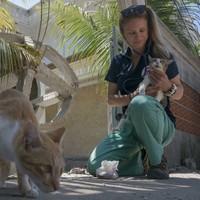
Disease, Death and Dog Meat – The Public Health Risk that no one wants to talk about
A first-hand account of the gruesome dog (and cat) meat trade
Fetid drowning pits. Homemade stun guns. Cyanide and strychnine poisoning. Blowtorching. Bludgeoning of live animals in the middle of a crowded market. It’s hard to image a scene more fraught with overt cruelty, infectious disease, and wanton disregard for public health.
A profit-driven, illicit industry completely devoid of any oversight, the dog meat trade is often overlooked as a pandemic in waiting. The trade already has the potential to kill countless people from rabies alone. Further exacerbating the public health risk are the practices associated with the trade including brutal capture, grueling transport, holding of animals for days on end in overcrowded conditions, and unhygienic, crude slaughtering practices; all of which create the perfect storm for the potential creation of new pathogens capable of infecting humans. Over the last months, global media accounts of China’s live animal markets have gone viral, already confirming what those of us working on the ground have known for years – the trading, brutality, and slaughtering of animals can have severe consequences on public health.
Investigating the dog and cat meat is absolutely heartbreaking and gut wrenching, and it never gets easier. And while every country, city, holding area, market and slaughterhouse is inherently different, all share particular similarities: the smells, sights, and sounds that are permanently etched into my memory.
The Smells
What tends to hit me first are the putrid smells associated with the trade. As facilities are rarely cleaned, they tend to have an odor that can best be described as nauseating and putrid. Covered in feces and urine from dogs desperately try to escape from whatever holding cage they are in, floors are caked in filth. Pools of blood accumulating in the slaughtering areas also have a particular stench, and in some cases, this blood is collected in buckets to make gravy, left to sit throughout the day and bake in the Southeast Asian heat and humidity. A particularly unforgettable smell is that of fur being scorched off carcasses and live animals. For days after visiting one particular market, I continued to smell the lingering odor of the blowtorched fur in my own hair, no matter how many times I attempted to wash it, continuously haunting me of the scenes I had witnessed earlier.

The Sights
The scenes involved in the trade are fraught with blatant disregard for both animals and public health. As a veterinarian, the animals themselves draw my attention first, however the harrowing environment itself is difficult to ignore. The appearance of sick and injured animals is common, many with severe nasal discharge, twitching with neurologic disease, suffering from severe dehydration or broken bones from being beaten during the capture process. The animals are handled with no regard for their welfare, often being beaten into submission. The scenes associated with the trade tend to be chaotic; butchers and traders fill up drowning pits, unloading cages, and switching out gas canisters for blowtorches, killing animals as quickly as possible. In some places the wildlife trade is associated with that of dog and cat meat – in one particularly memorable setting, monkeys were chained above a drowning pit which killed over 100 dogs per day by submerging them until the air bubbles stopped. At a cat meat wholesaler, freezers were packed with frozen cat meat while bottles of pickled monkeys and baby tigers sat on a shelf awaiting sale.

The Sounds
Perhaps most haunting aspect of investigations are the sounds of the animals screaming, howling, whimpering, some frantically trying to chew or claw their way out. Aside from the animals themselves, the background noises can be just as overwhelming. Traders yelling, shouting, the banging of the heavy metal cages as they are being offloaded or moved.
Live animal markets are only a part of the trade
Since the COVID-19 pandemic emerged, there has been a global outcry to address the very live animal markets from which the pathogen originated. As it pertains to the dog and cat meat trade however, it’s important to address not only the markets, but the entire process; animals don’t just start and end up at a market. Their journey usually lasts days if not weeks, transported under brutal conditions from hundreds of kilometers away, putting a multitude of people at risk from disease along the way. While media attention has been on the very markets themselves, one should consider the sheer public health risk that all practices associated with the trade pose to those involved, not only at the markets. The includes the dog and cat catchers, traders, wholesalers, transporters, market vendors, butchers, the public, and tourists who might be visiting these markets. Considering the very nature of the trade and the way it operates, what I have seen makes me positive that regulation of the trade to moderate these risks is practically impossible – a complete ban is the only way.
Make no mistake, fighting the cat and dog meat trade is not about catering to Western sensitivities, or debating what is eatable and what is not. Rather, it is a battle for life and death, both of animals and of people. It’s about tackling not only the cruelty and suffering endured by millions of companion animals, but also protecting local communities, international visitors, and promoting international reputation of the cities and countries themselves. I can only hope that sharing my experiences can help bring change to a practice that has no place in the 21st century and may just lead to the next global pandemic.

Dr. Katherine Polak
Former FOUR PAWS Head of Stray Animal Care - Southeast AsiaKatherine previously managed the FOUR PAWS companion animal programs in Southeast Asia, with a special focus on combatting the cruel dog and cat meat trade.

